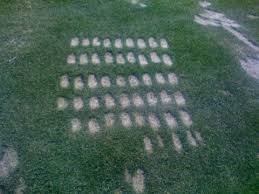What you can learn from “divots”
The first golf Instruction I had was in a group lesson. I remember there was quite a lot of us and we all stood in a line hitting balls and the professional came along and gave each of us a piece of advice during the couple of minutes he had with each person. Although the Professional was expected to work miracles in the impossibly short time he had I can still vividly recall the advice he gave to me. He told me told me to look at my divots after each shot and try to straighten them up as they were pointing very left of where the ball ended up. I was typical of a lot of beginner golfers as I had a big slice with my shots (the ball curling from left to right). This also had a big influence on my interest on learning the how the swing works as I wanted to get a better understanding of why and what was happening.
Unfortunately, due to the time the pro had with us, it took me a little while to add in the vital information of body alignment in relation to a specific target line was important to be able to eliminate alignment as the reason why my divots went left. This opened the door to me getting rid of my slicing swing shape but it all started with the simple feedback of learning from the shape of my divots.
In my case the divot shape was a simple straight divot that went left this is a good indication of an out –to –in swing path. A divot pointing straight right are likely to indicate an in –to –out swing path which will cause a hooking or exaggerated draw shape (ball curling from right to left). Be careful though to look closely at the divot pointing left – if the divot shape is more curved (like a reversed C shape) rather than a straight divot, it only shows you that club has very quickly turned to the left after impact and this may not be due to a swing path issue but can indicate ball position being too forward or too much arm and club head rotation through impact (this may be referred to as too much manipulation).
Be mindful to check where you divot or ground contact starts in relation to your feet and ball position. Quite often there is a correlation with in –to – out swing divots and catching the ground early but having a shallow divot. And the opposite of a steep or very deep divot taken more forward in relation to the feet are good indications of a choppy out – to- in swing.
Check the width of the divot, it should be consistent with the width of the club head. If the divot is too deep on one side it gives you an indication of the angle you are swinging down in relation to a down the target line viewpoint. This sometimes can be an indication of your Irons not being fitted correctly, but may also show swing problems.
If you are on a grass range and hitting a number of balls with the same club then look for consistency in your divots, not just in line but in depth as well. For sure looking at the turf doesn’t tell you the whole story about your swing but it can give you some valuable feedback about swing paths and angle as well as consistency but don’t forget to check alignment. It is also a very simple external thought to have when trying to alter more complicated movements of your body.
Paul Thompson has been the Fellow PGA Professional at Powerscourt Golf Club in Wicklow since 1995. In addition to providing coaching on-site he also is a coach with The Golfing Union of Ireland. Appointments with Paul can be booked via Powerscourt Golf Club Reception: Tel (01) 204 6033 or the Golf Shop Tel (01) 204 6031. Read more about lessons from Paul Thompson by visiting the Powerscourt Golf Club Website.



